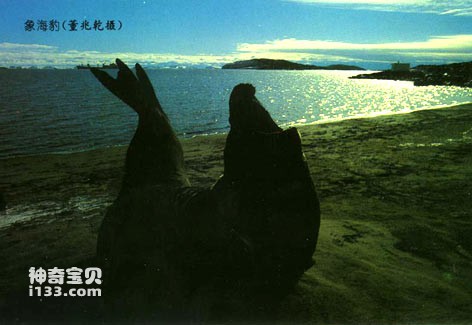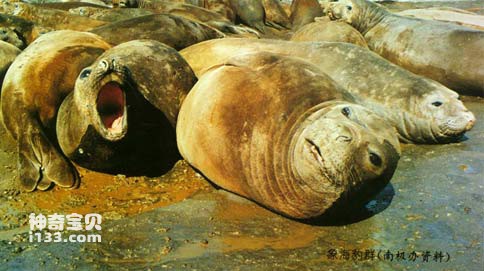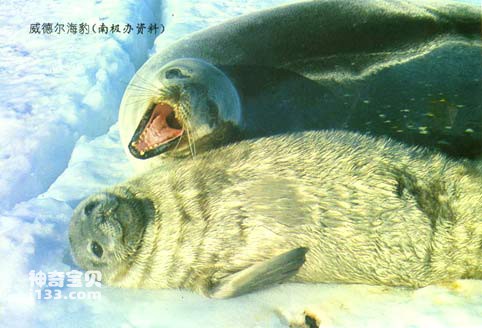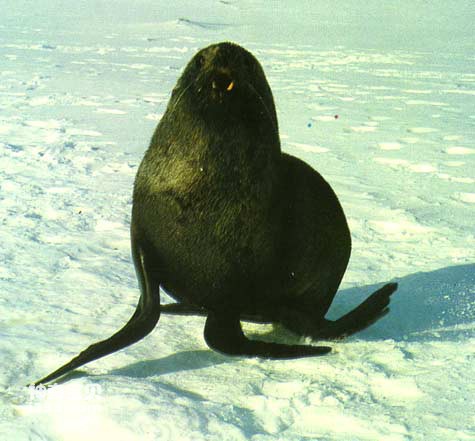There are six species of seals that inhabit the south of the Antarctic Convergence Zone, namely saw-tooth seals, elephant seals, leopard seals, Weddell seals, Ross seals and sea lions. The largest is the elephant seal, and the most numerous is the saw-toothed seal. Among these six species of seals, saw-toothed seals, leopard seals, Weddell seals and Ross seals are endemic to the Antarctic region. Seals in the Antarctic region are mainly distributed along the coast of the Antarctic continent, in floating ice areas and in the waters around some islands.

1. Elephant seal
Elephant seals are also called elephant seals and walruses. They are the largest seals. The male is 4 to 6 meters long and weighs 2 to 3.5 tons. The female is smaller than the male and weighs half of the male. It is easy to distinguish between a big husband and a small wife. Its number is about 700,000.

The elephant seal gets its name because there is a unique and elastic muscle above its lip, which is shaped like an elephant's trunk. It is usually floppy and droopy. When angry or fighting, it bulges very high and stretches very long. , sometimes up to 50 cm long. The fur of elephant seals is grayish-yellow, sometimes grayish-white, and the color varies slightly with age and season. Elephant seals are ugly and clumsy. They feed on krill and squid. They like to live in groups and breed on land, giving birth to one calf per litter.
2. Leopard Seal
Leopard seals are 3 to 4 meters long. Females are larger and heavier, about 300 to 500 kilograms, but males only weigh 200 kilograms. Leopard seals have spots all over their bodies and look like leopards. It has a ferocious temperament, flexible movement, fast swimming speed, sharp teeth, and a keen sense of smell. It is good at attacking prey and often attacks penguin groups unexpectedly. It has a wide range of feeding habits. In addition to eating krill, fish and cephalopods, it also eats penguins, birds and small saw-toothed seals. It is known as the sea robber, and other species of seals are afraid of it and avoid it. There are only 220,000 leopard seals. They mate in the water and breed on the ice, giving birth to one calf per litter.
3. Saw-toothed seal
Saw-toothed seals, also called crab-eating seals, are about 2.5 meters long and weigh more than 200 kilograms. Females are larger than males. Its body color ranges from silvery gray to dark gray, sometimes light red, with the back being darker than the belly. The saw-toothed seal has rows of sharp teeth in its mouth, arranged staggered up and down, much like saw teeth, hence its name. It feeds on krill. It is an illusion to call it a crab-eating seal because there are very few crabs in Antarctica and there are not enough crabs for it to eat. 85% of saw-toothed seals have body scars caused by attacks by killer whales, some from fighting for mates.
Female saw-toothed seals become sexually mature in 2 years and have a 9-month gestation period. They reproduce on sea ice and give birth to one calf per litter. In the warm season, saw-toothed seals form breeding families: a female seal leads several children, and sometimes a male seal temporarily joins them to live on the sea ice. In other seasons, they are active on the edge of the ice floe. Sometimes small groups of thirty or forty individuals are seen, but large groups are rare.
Saw-toothed seals are the most numerous species of Antarctic seals, with about 30 million individuals, accounting for more than 90% of the total number of Antarctic seals. They are also the most numerous species of seals in the world, accounting for 85% of the world's total seals. It is said to be the most numerous large mammal in the world today.

4. Weddell seal
Weddell seals are about 3 meters long and weigh more than 300 kilograms. Females are slightly larger than males. Its back is black, other parts are light gray, and there are white spots on its sides. There are about 750,000 of them. It breeds on ice and gives birth to one calf per litter. The milk fat content is high, and the pups are particularly fat and cute. Weddell seals are found in sea ice areas and can spend long, dark winters under the sea ice. It uses its sharp teeth to gnaw holes in the ice, stick out its head, and breathe, or it can drill out of ice holes and live alone. It is rare to see them in groups. Females mostly live on the ice, and males mostly live in the water. The two mate in the water. Weddell seals are excellent long and deep divers, feeding on fish, squid and krill.
5. Ross Seal
Ross seals live in areas of floating ice that are difficult for people to reach, and little is known about them so far. It is about 2 meters long. The female is larger than the male. It has a small head and big eyes. It is also called a big-eyed seal. Its number is about 250,000 to 500,000. It likes to move and live alone, rarely in groups, and feeds on deep-water squid.
6. Sea lion
Sea lions are also called fur seals, sea wolves or sea bears. They are about 2 meters long and weigh about 150 kilograms. There are 900,000 in number. Its fur is grayish-yellow, fine, and luxurious. Its obvious feature is that its fins are long and supported by its fins and tail. It can stand and walk on land at a very slow speed. Sea lions mainly live in the waters around Antarctic oceanic islands, mate in the water and give birth on the beach. Their food habits are relatively simple, mainly feeding on krill.

Based on the sea lion's habit of eating krill, scientists installed an automatic electronic recorder on it to monitor its swimming speed and activity range, thereby inferring the distance, size and dynamic changes of the krill group.
Sea lions have long been the target of hunting for their luxurious fur. Thanks to the corresponding protection measures taken by the international community, they have been saved from extinction. In recent years, their numbers have slowly recovered.
animal tags: Seal walrus krill squid
We created this article in conjunction with AI technology, then made sure it was fact-checked and edited by a Animals Top editor.